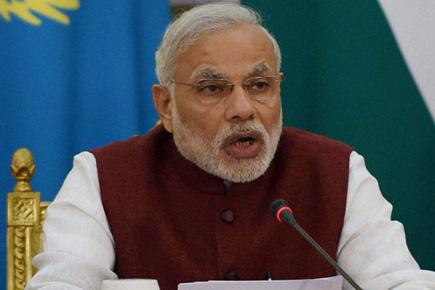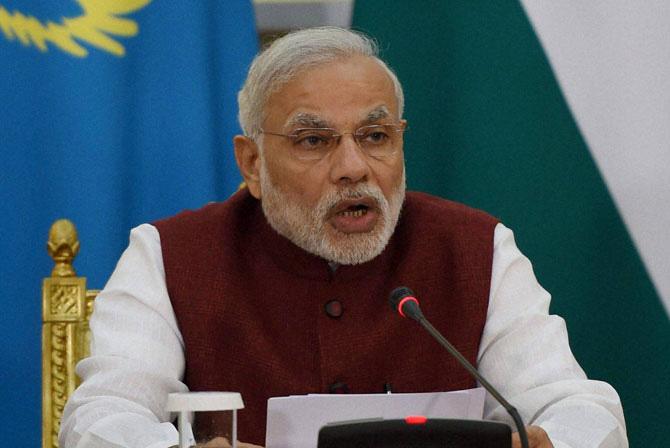Monday's stock market decline marks a landmark of sorts for the Narendra Modi government. The markets have come back to levels they had last seen when Modi went on to take over the reins of State

Mumbai: Monday's stock market decline marks a landmark of sorts for the Narendra Modi government. The markets have come back to levels they had last seen when Modi went on to take over the reins of State. Is the Modi exuberance over?
ADVERTISEMENT
The BSE sensitive index closed at 24,983, down 308.09 or 1.22 percent from the previous close. The Nifty saw a fall of 1.26 percent or 96.25 points at 7,558.80.
On May 16, 2014, the general election results were announced sending Modi to 7 race course road, the PM's residence, triggering a bull run which had rarely been seen in Indian stocks.
Monday's decline brought that steady rise to the level seen on that fateful day last year, when the BSE Sensex went up to 25,375 before closing at 24,121. CNX Nifty went up to 7,563 and closed at 7,203, echoing the trades done one year and four months later.
This may not indicate the end of the Modi government-led exultation, but it does indicate that markets can decline at the best of times and the euphoria seen may not last forever.

Narendra Modi. File pic
Monday's slide was led by lacklustre Chinese markets coupled with weaker-than-expected monsoon rains and a falling rupee. All this eroded investor confidence leading the barometer index of the Indian equities to shed over 308 points.
The Sensex touched a high of 25,387.32 points and a low of 24,851.77 points in the intra-day trade.
Analysts elaborated that the markets were in an over-sold position, which hindered the investors to chase higher prices. In addition, lack of any positive triggers and the expectation of a US rate hike had flared anxiety amongst investors.
"Investors were reluctant to chase higher prices, as markets were already in an over-sold position. There were also no new triggers for the markets to react," Alex Mathews, head, research, Geojit BNP Paribas Financial Services.
Mathews further pointed out that the Asian cues remain negative, after the downward revision of Chinese gross domestic product (GDP) growth figures.
Among the Asian markets, Hong Kong's Hang Seng dropped by 1.23 percent, China's Shanghai Composite Index lost 2.55 percent. However, Japan's Nikkei inched-up by 0.38 percent.
Furthermore, the rupee's continued slide spooked investors.
The rupee hit a new two-year low of 66.86 against the greenback in the intra-day trade. It closed at 66.82, losing 36 paise from its previous close of 66.46.
The Indian currency had last breached the 66.80-level to a greenback on September 4, 2013.
Rupee came in for a beating, as frantic dollar-buying in China devalued the off-shore yuan and other Asian currencies, including the rupee.
The volatility started after reports from China suggested that the central bank there was planning to impose stringent regulations on foreign exchange purchases from October to curb speculation and volatility.
Interestingly, the Chinese yuan was two percent weaker in off-shore markets than domestically.
"The rupee was impacted from the pressure put on yuan and the expected shortfall of dollars in China due to the reports on new regulations," Anindya Banerjee, associate vice president for currency derivatives with Kotak Securities explained to IANS.
Other triggers, such as a lowering of monsoon rainfall projections subdued investor confidence. The India Meteorological Department (IMD) lowered its long period average rainfall project from 88 percent to 81 percent.
The IMD had earlier said that the overall monsoon deficit would stand close to 14 percent.
The weakening of monsoon might end up having a negative bearing on the Reserve Bank of India (RBI)'s decision on a next phase of rate cuts.
"Despite positive opening for the markets, the Nifty is down around 1.26 percent, due to weakening of Indian rupee and also IMD's further lowering of the monsoon forecast," Vaibhav Agrawal, vice president, research, Angel Broking explained to IANS.
Sector-wise, all 12 sub-indices of the BSE closed in the red. Intense selling was observed in BSE's healthcare, banking, capital goods, automobile, metal and fast moving consumer goods (FMCG) stocks.
The S&P BSE healthcare index plunged by 440.18 points, banking index plummet by 387.15 points, capital goods index receded by 291.75 points, automobile index declined by 196.48 points, metal index was lower by 1164.30 points and FMCG index dropped by 114.39 points.
Major Sensex gainers during Monday's trade were only: HDFC, up 0.64 percent at Rs.1,149.45, Tata Motors, up 0.23 percent at Rs.323.60, ONGC, up 0.18 percent at Rs.226 and Maruti Suzuki, up 0.07 percent at Rs.4,072.05.
The major Sensex losers were: Axis Bank, down 3.90 percent at Rs.450.55; Vedanta, down 3.59 percent at Rs.89.95, ICICI Bank, down 3.34 percent at Rs.249.25, Hindalco Industries, down 3.05 percent at Rs.71.60 and Lupin, down 2.96 percent at Rs.1,804.20.
 Subscribe today by clicking the link and stay updated with the latest news!" Click here!
Subscribe today by clicking the link and stay updated with the latest news!" Click here!






